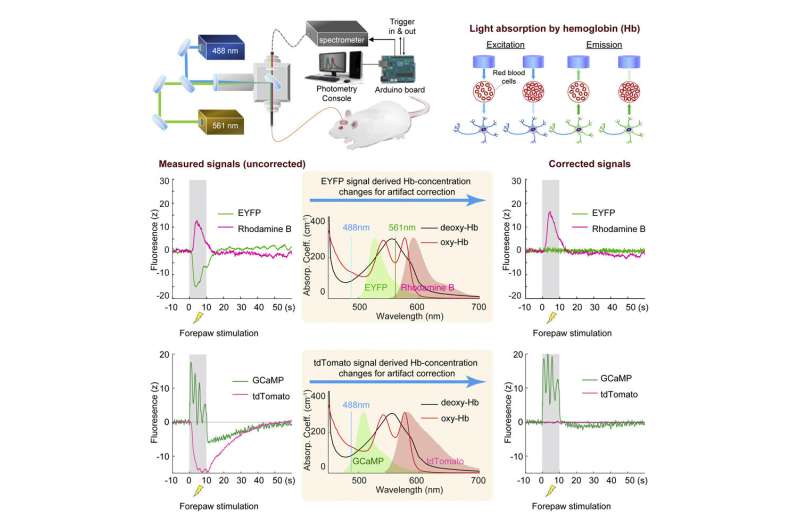Graphical abstract. Credit: Cell Reports Methods (2022). DOI: 10.1016/j.crmeth.2022.100243
UNC School of Medicine researchers, led by Ian Shih, Ph.D., associate professor of Neurology and Biomedical Research Imaging Center, developed an improved fiber-based optical method to measure activity changes in the brain.
Fiber photometry, an increasingly used neurotechnology, uses fiber optics to deliver certain wavelengths of light to excite fluorescent proteins responsive to that wavelength and record activity-dependent light emission. Through this process, scientists can directly measure activity from specific population of cells or neurochemicals within a specified location of the brain.
However, not all the light gets through—a significant amount is absorbed by the hemoglobin (Hb) in blood vessels distributed throughout the brain, and there was previously no reliable method to quantify this influence in fiber photometry. In a research article featured in Cell Reports Methods, co-authors Weiting Zhang, MD, Ph.D., and Tzu-Hao Harry Chao, Ph.D., describe a novel method to quantify this hemoglobin absorption in fiber photometry and demonstrate how to use their method to obtain a more accurate measurement of brain activity changes.
"Given the rapidly increased usage of fiber photometry in neuroscience and the significant light absorption by hemoglobin, we realized that it is important to correct relevant artifacts in photometry measures. Our specific approach is to take a photon reading across wavelengths from an activity independent fluorescent protein and use the known hemoglobin absorption coefficients to compute hemoglobin dynamics. This information then allows us to restore the underlying fluorescent signal dynamics from the targeted cells, artifact free," said Zhang, who is first author and works in a research unit under the Department of Neurology and Biomedical Research Imaging Center.
Movement of simulated light paths that blue and green photons travel. Credit: University of North Carolina at Chapel Hill School of Medicine
"We have now implemented a few approaches to correct for hemoglobin absorption artifacts—one of which does not require an extra activity independent fluorescent protein expression and can readily be used to measure multiple sensors at once. The beauty of our platform is that it is readily scalable to multiple regions, and adaptable to study transfer functions between neuronal activity, neurotransmitter release, as well as vascular dynamics," said Chao, co-first author and staff scientist in the Center for Animal MRI.
To best disseminate their methods and help scientists elsewhere to reproduce this technology, Zhang and Chao also published a protocol paper that contains step-by-step instructions and their analytical codes in the journal STAR Protocols.
"We would love to share our technique with our colleagues on campus. Please contact us via photometry@unc.edu if you are interested in using multi-channel spectral fiber photometry for your research," Zhang said.
"Zhang et al. (2022) highlight the importance for recognizing and correcting hemoglobin artifacts in fiber photometry data, beyond what the field currently does… It is particularly important to consider when performing fiber photometry recordings during pharmacological interventions in vivo, which can cause large changes in cerebral blood volume. In these contexts, using their computational models along with a spectrometer can remove unwanted hemoglobin absorption artifacts, leading to more accurate neuronal recording data with fiber photometry," said Run Zhang and Christina Kim of University of California, Davis, in their preview article covering this study on Cell Reports Methods.
More information: Wei-Ting Zhang et al, Spectral fiber photometry derives hemoglobin concentration changes for accurate measurement of fluorescent sensor activity, Cell Reports Methods (2022). DOI: 10.1016/j.crmeth.2022.100243
Journal information: Cell Reports Methods
























